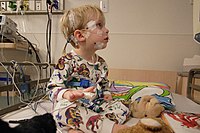
Photo from wikipedia
Background Despite good evidence that the prevalence of sleep-disordered breathing (SDB) is increasing in the general population, no data are available about trends in poststroke SDB. We therefore sought to… Click to show full abstract
Background Despite good evidence that the prevalence of sleep-disordered breathing (SDB) is increasing in the general population, no data are available about trends in poststroke SDB. We therefore sought to assess changes in poststroke SDB over a 10-year period (2010-2019). Methods and Results Participants in the BASIC (Brain Attack Surveillance in Corpus Christi) project were offered a home sleep apnea test to assess for SDB after stroke. SDB assessment procedures remained unchanged throughout the study period. Respiratory event index was calculated as the sum of apneas and hypopneas per hour of recording. SDB was defined as respiratory event index ≥10/h for optimal sensitivity and specificity of the home sleep apnea test device compared with in-laboratory polysomnography. Regression models were used to test associations between SDB prevalence and severity and time, with adjustment for multiple potential confounders. Among the 1215 participants who completed objective sleep apnea testing, the prevalence of SDB grew from 61% in the first year of the study to 76% in the last, with 1.1 times higher odds each year (95% CI, 1.07-1.19), after adjustment. A linear association was identified between time and respiratory event index (average annual respiratory event index increase of 0.56/h; 95% CI, 0.20/h-0.91/h), after adjustment. There was no difference in time trends by sex or ethnicity. Conclusions The prevalence and severity of SDB after ischemic stroke has increased over the past 10 years in this population-based cohort. These data highlight the need to determine whether SDB treatment improves stroke outcomes.
Journal Title: Journal of the American Heart Association
Year Published: 2022
Link to full text (if available)
Share on Social Media: Sign Up to like & get
recommendations!